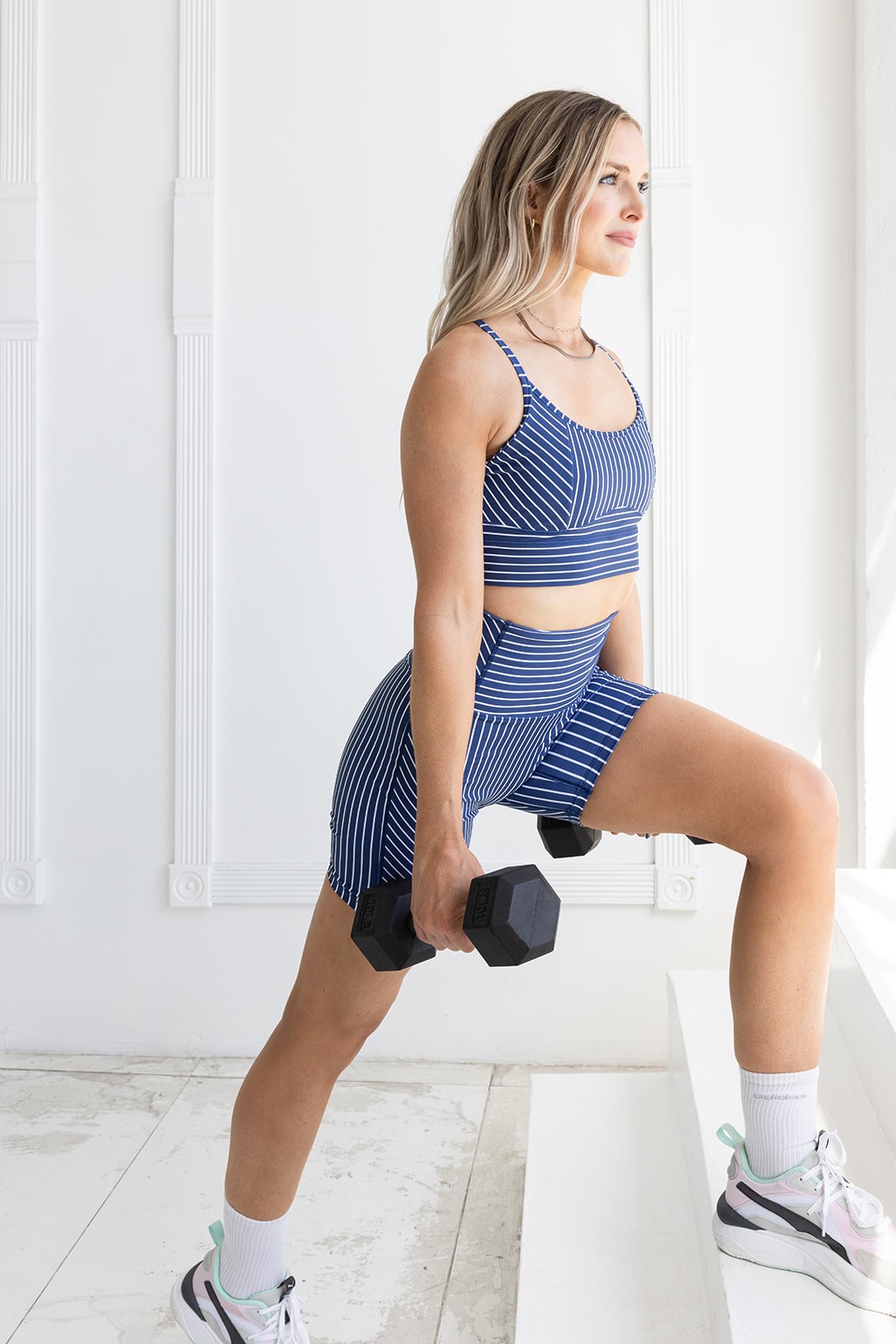Types of exercise
Recovery
Fitness myths
Evlo Programs
BODY COMPOSITION
All
Browse by category
Browse by category
How to safely increase the number on your dumbbell
Payton Busker
4/01/2022
Written by

at home workout, avoid overtraining, body composition, building muscle, dosage of exercise, how to build muscle
By: Dr. Payton Busker, PT, DPT
Choosing appropriate external load (i.e. weights) and steadily increasing that load is essential to progressing your fitness routine. But this choice (and the progression) can be very confusing! How do we know where to start? Are there steps to take prior to picking up a heavier dumbbell? And when is it time to add resistance? All of these questions will be answered in today’s blog post!

Our goal at Evlo is muscle hypertrophy.
Muscle hypertrophy is the physical increase in muscle size through growth of contractile proteins within the muscle. This increase can lead to many improved health measures such as insulin sensitivity, cardiovascular health, and body composition. Although hypertrophic changes do not have a direct 1-to-1 ratio with strength improvements (ability of your muscle to produce force), increasing the muscle size is shown to allow for more force production through an individual muscle.
In order to achieve true muscle hypertrophy, you must almost reach muscle failure with each exercise set.
This is not to say that your whole body should feel exhausted, but rather the specific muscle you are working should be fully fatigued. Here at Evlo, we call that “cooked”!
In aiming to achieve muscle hypertrophy, it is also important to recruit as many muscle fibers as possible.
There are 4 muscle fiber subtypes:
1. Type I (slow, fatigue resistant)
2. Type IIA (fast, fatigue resistant)
3. Type IIAB (fast, intermediate fatigability)
4. Type IIB (fast, fatigable)
These muscle fiber types are recruited sequentially.
In order to best recruit all fiber types, an exercise should be performed between 60-90 seconds with near muscle failure achieved at the end of this time period. Practically, this feels like you could only do 1-3 more reps of that exercise once the set is finished. Here is where weight selection becomes important!
Initial weight selection:
When you first begin Evlo, we recommend starting with the following weight selections:
- Heavy: 8lbs or less
- Moderate: 5 lbs or less
- Light: 1-3 lbs
However, you might have to experiment with the exact weight that is right for you for various exercises! Remember, the muscle should feel fully fatigued by the end of each exercise set in class.
Let’s look at an example.
You decide to use 5lb dumbbells for your biceps curls in your first week of Evlo. You notice that at the end of the first set of biceps curls in class, you feel like you could continue the exercise for >4 repetitions. In this example, you are not reaching true biceps muscle fatigue and are most likely primarily recruiting the Type I muscle fibers. Although this is not dangerous or “bad”, it will not progress you towards your goal of biceps muscle hypertrophy. You might instead choose 6-7 lb dumbbells for your biceps curls! Don’t be afraid to experiment.
Let’s say you have been an Evlo member for a few months and you have yet to increase your weights. Should you go out and buy heavier weights right away?
I propose you look at these two factors first!
1. Pace of the exercises
2. Internal resistance
The pace at which you perform an exercise can drastically change the effectiveness of the exercise.
And it is an easy variable to adjust! The faster you perform an exercise, the less forceful your muscular contraction becomes. This is based on the force-velocity relationship (force x velocity = power).
Slow and steady really wins the hypertrophic race.
In order to recruit as many muscle fibers as possible, I recommend that you slow your exercises down prior to changing your external resistance. More specifically, focus on the slow lowering phase of each exercise. This contraction, known as an eccentric contraction, occurs when a muscle is loaded as it lengthens. Studies show that more type IIX (or type IIB) fibers are recruited in eccentric training.
Remember: the more muscle fibers we can recruit, the better!
Increasing your internal resistance can also lead to hypertrophic changes.
As discussed in a previous blog post, we can use verbal instruction and mental visualization to enhance internal resistance. But is greater internal resistance shown to enhance muscle activation? One study tested this theory using trunk curls for abdominal activation.
The researchers noted a significant improvement in muscle activation of the obliques and rectus abdominis muscles with one changed variable: simple, verbal instructions. In Evlo, we provide these verbal instructions in each and every class!! In addition, we recommend that you imagine “squeezing with 100% effort” or that imagine “lifting a 100 lb dumbbell”.
Specific focus on muscle activation is shown to lead to muscle hypertrophy.
In the linked study, researchers divided subjects into “internal” and “external” focus groups. The internal focus group was instructed to focus on specific muscle activation while the external focus group was to focus on the outcome of the lift. The internal focus group experienced a significantly greater increase in muscle tissue thickness as compared to the external focus group. Yay for muscle hypertrophy!!

Is it time to increase external load for a specific exercise yet??
Did you:
1. Pick an appropriate starting weight when you first began Evlo?
2. Slow your exercises down and focus on eccentric loading?
3. Implement the concept of increasing your internal resistance?
Are you able to continue the specific exercise long after the instructor ends the set?
If you answered yes to all of the above, it may be time to pass go (read: go up in weight!!).
We recommend an increase in 1-2 pounds for upper body exercises and 3-5 pounds for lower body exercises. Again, don’t be afraid to experiment! Notice if the increase you chose makes it too difficult to finish a set of exercises. Maybe back it down by a pound! If your increase in weight does not lead to that specific muscle fatigue at the end of a 60-90 second set, maybe go up by another pound!
We are in this for the long haul.
It is worth tweaking your routine to avoid progressing too quickly!
Progressively increasing our external resistance over time IS something we want to do IF the goal is continued muscle hypertrophy.
In order to make hypertrophic changes, a certain level of stress to an individual muscle must be achieved. Our muscles are highly adaptable and, over time, become less and less affected by a specific load. Therefore, in order to achieve continued muscle growth, the external load must be increased.
The good news?
You do not need to “confuse” your muscles by changing the specific exercise you are doing.
Instead, you can appropriately increase the external resistance for the same exercise following the steps outlined above.
References:
Force-velocity relationship: https://courses.lumenlearning.com/boundless-ap/chapter/control-of-muscle-tension/
Eccentric training: https://www.mvclinic.es/wp-content/uploads/Friedmann-Bette-et-al-2010.pdf
Core activation: https://www.jospt.org/doi/10.2519/jospt.2004.34.1.4?url_ver=Z39.88-2003&rfr_id=ori:rid:crossref.org&rfr_dat=cr_pub%20%200pubmed
Muscle hypertrophy with attentional focus: https://www.tandfonline.com/doi/abs/10.1080/17461391.2018.1447020?journalCode=tejs20
Available on:
Start free trial
Join our community where you no longer need to deplete yourself to see fitness results.
